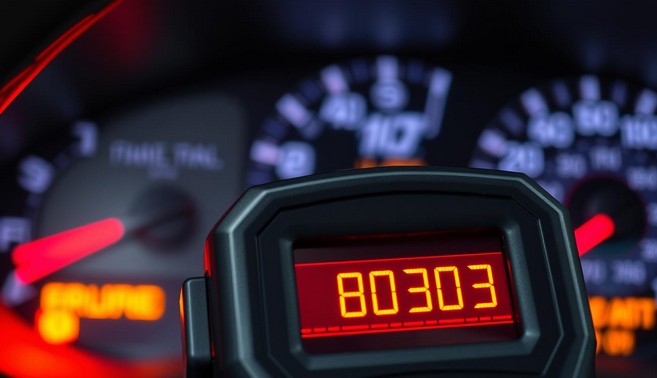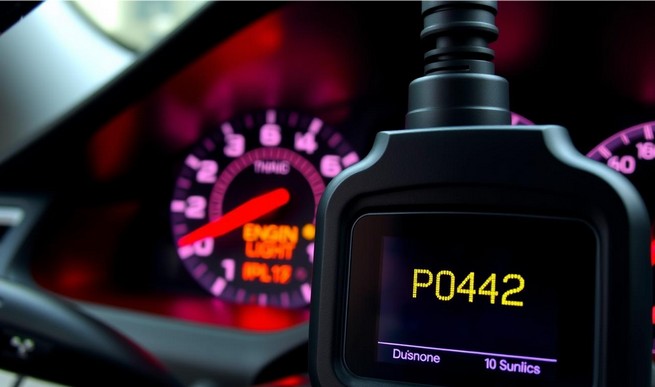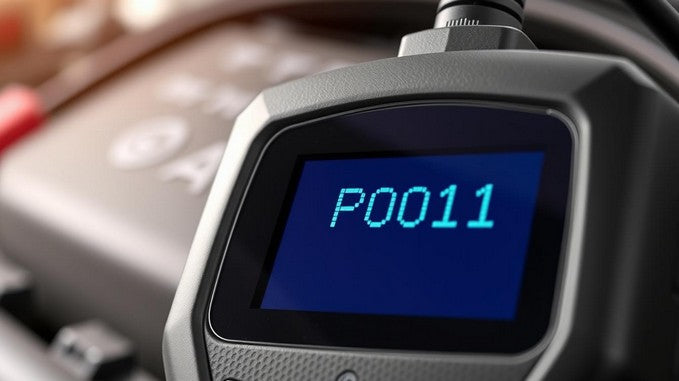Seeing the P0303 code on your scanner can be concerning, but understanding what it means is the first step toward fixing it. The P0303 code indicates a cylinder 3 misfire detected by your vehicle's computer system. This issue requires attention as it can lead to decreased performance, poor fuel economy, and potential engine damage if left unaddressed. In this comprehensive guide, we'll walk you through what this code means, why it happens, and how to fix it—whether you're a DIY mechanic or planning to visit a professional.
The P0303 code indicates a misfire specifically in cylinder 3 of your engine
What Does the P0303 Code Mean?
The P0303 trouble code specifically means "Cylinder 3 Misfire Detected." When your vehicle's powertrain control module (PCM) detects that cylinder 3 is not contributing power as expected during the combustion process, it triggers this code. A misfire occurs when the air-fuel mixture in the cylinder fails to ignite properly or doesn't ignite at all.
Breaking down the code:
- P - Indicates it's a powertrain-related code
- 0 - Refers to a generic OBD-II code (as opposed to manufacturer-specific)
- 3 - Relates to the ignition system or misfire
- 03 - Identifies the specific cylinder experiencing the issue (cylinder 3)
Cylinder 3's location varies by engine configuration - consult your vehicle's manual for exact positioning
How Urgent Is a P0303 Code?
A P0303 code should be considered moderately to highly urgent depending on the severity of the symptoms. While you might be able to drive briefly with this code present, continued driving with a misfiring cylinder can lead to:
Potential Consequences of Ignoring P0303
- Catalytic converter damage (expensive to replace)
- Increased emissions and potential test failures
- Reduced fuel economy
- Engine performance degradation
- Complete engine failure in severe cases
Is Your Check Engine Light On?
Don't risk expensive engine damage. Take action now to diagnose and fix your P0303 code.
Common Causes of the P0303 Code
Several issues can trigger a P0303 code. Understanding these potential causes can help you narrow down the problem and find the right solution.
Worn or fouled spark plugs are a common cause of cylinder misfires
Ignition System Issues
- Faulty spark plug in cylinder 3
- Damaged or worn ignition coil
- Cracked distributor cap (older vehicles)
- Broken or worn spark plug wires
Fuel System Problems
- Clogged or faulty fuel injector
- Fuel pressure issues
- Poor fuel quality
- Vacuum leaks affecting fuel mixture
Mechanical Engine Problems
- Low compression in cylinder 3
- Leaking head gasket
- Worn valve seals or guides
- Camshaft timing issues
Heat Soak: A Common Culprit for Cylinder 3
Many vehicle owners report that cylinder 3 is particularly prone to misfires due to its position in the engine. In many engine configurations, cylinder 3 is located near the exhaust manifold, making it susceptible to heat soak. This excessive heat can cause the fuel in the injector to vaporize before it's supposed to, leading to misfires. Some manufacturers have issued Technical Service Bulletins (TSBs) recommending heat shields for the affected injector.
Installing a heat shield around the cylinder 3 fuel injector can prevent heat-related misfires
Symptoms of a P0303 Code
When your vehicle has a P0303 code, you may notice several symptoms beyond just the check engine light. Recognizing these signs can help confirm the issue before diagnostic testing.
A rough, unstable idle is a common symptom of a cylinder misfire
Noticeable Performance Issues
- Engine vibration or shaking, especially at idle
- Rough running or hesitation during acceleration
- Loss of power when driving uphill or carrying loads
- Jerking or bucking during steady cruising
- Stalling in severe cases
Other Observable Symptoms
- Check Engine Light illuminated on dashboard
- Decreased fuel economy (10-20% reduction is common)
- Strong fuel smell from exhaust
- Black smoke from exhaust pipe
- Engine running hotter than normal
Important: If you experience severe shaking, significant power loss, or the engine is running extremely rough, stop driving immediately. Continuing to drive could cause expensive damage to your catalytic converter and other engine components.
Experiencing These Symptoms?
Don't wait until your engine suffers permanent damage. Follow our diagnostic steps or consult with a professional mechanic today.
How to Diagnose a P0303 Code
Diagnosing a P0303 code involves a systematic approach to identify the specific cause of the cylinder 3 misfire. Here's a step-by-step process you can follow, starting with the simplest checks.
An OBD-II scanner is essential for confirming the P0303 code and checking for additional related codes
Step 1: Verify the Code
First, confirm that you're dealing with a P0303 code using an OBD-II scanner. Check for any additional codes that might be present, as these can provide clues about related issues.
Inspect spark plugs for signs of fouling, damage, or improper gap
Step 2: Visual Inspection
Perform a visual inspection of the ignition components for cylinder 3:
- Locate cylinder 3 (consult your vehicle's manual for the exact location)
- Check for damaged, loose, or disconnected spark plug wires or coil connectors
- Look for obvious signs of damage, corrosion, or oil contamination
- Inspect vacuum hoses for cracks, splits, or disconnections
Swapping ignition coils between cylinders is an effective diagnostic technique
Step 3: Component Testing
If visual inspection doesn't reveal the problem, proceed with component testing:
|
Component |
Test Method |
What to Look For |
|
Spark Plugs |
Remove and inspect |
Fouling, damage, improper gap, oil contamination |
|
Ignition Coil |
Swap with another cylinder |
If misfire moves to the other cylinder, the coil is faulty |
|
Fuel Injector |
Listen with mechanic's stethoscope |
Clicking sound indicates operation; can also swap with another cylinder |
|
Compression |
Compression test |
Low compression indicates mechanical engine problems |
Step 4: Advanced Diagnostics
If basic tests don't identify the issue, consider these advanced diagnostic methods:
- Perform a cylinder leak-down test to check for internal engine leaks
- Use a fuel pressure gauge to verify proper fuel system pressure
- Check for exhaust leaks at the manifold near cylinder 3
- Test the vehicle's PCM if all other components check out
Need Professional Diagnostic Help?
If you don't have the tools or experience to perform these tests, professional mechanics have specialized equipment to pinpoint the exact cause of your P0303 code.
P0303 Code Repair Solutions
Once you've diagnosed the cause of your P0303 code, you can proceed with the appropriate repair. Here are the most common solutions based on the underlying issue, along with estimated costs.
Replacing spark plugs is often the first and most affordable fix for a P0303 code
|
Repair Solution |
DIY Cost |
Professional Cost |
Difficulty Level |
|
Replace spark plugs |
$20-$50 |
$100-$200 |
Easy |
|
Replace ignition coil |
$40-$100 |
$150-$300 |
Easy-Moderate |
|
Clean/replace fuel injector |
$15-$150 |
$200-$500 |
Moderate |
|
Install injector heat shield |
$20-$40 |
$100-$150 |
Easy |
|
Repair vacuum leak |
$10-$50 |
$100-$250 |
Moderate |
|
Head gasket replacement |
$200-$400 |
$1,000-$2,000+ |
Advanced |
Installing a heat shield on the cylinder 3 injector is a common fix for heat soak issues
DIY Repair Tips
If you're tackling the repair yourself, here are some helpful tips:
- Always use manufacturer-recommended or OEM-quality parts
- When replacing spark plugs, ensure they're gapped correctly
- Apply anti-seize compound to spark plug threads (if recommended by manufacturer)
- Check your vehicle's repair manual for torque specifications
- Clear the code after repairs and test drive to ensure the fix worked
Not Comfortable with DIY Repairs?
For complex repairs or if you lack the necessary tools, professional mechanics can quickly diagnose and fix your P0303 code.
Preventing Future P0303 Codes
Once you've fixed your P0303 code, taking preventive measures can help avoid future cylinder misfires and related issues. Regular maintenance is key to keeping your engine running smoothly.
Regular maintenance is the best way to prevent future misfire codes
Maintenance Schedule to Prevent Misfires
|
Maintenance Item |
Recommended Interval |
Prevents |
|
Spark plug replacement |
30,000-100,000 miles (per manufacturer) |
Misfires from worn plugs |
|
Ignition coil inspection |
Every 60,000 miles |
Coil failure and misfires |
|
Fuel system cleaning |
Every 30,000 miles |
Injector clogs and fuel delivery issues |
|
Air filter replacement |
Every 15,000-30,000 miles |
Poor air/fuel mixture |
|
Vacuum hose inspection |
Every oil change |
Vacuum leaks affecting fuel mixture |
Additional Prevention Tips
Fuel Quality Matters
- Use high-quality fuel from reputable stations
- Consider occasional fuel system cleaners
- Avoid running on a near-empty tank (can introduce sediment)
- Use the octane rating recommended by your manufacturer
Driving Habits
- Allow engine to warm up properly in cold weather
- Avoid excessive idling for long periods
- Address check engine lights promptly
- Don't ignore minor performance issues
Using quality fuel appropriate for your vehicle helps prevent engine misfires
Frequently Asked Questions About P0303 Code
Can I drive with a P0303 code?
While you might be able to drive short distances with a P0303 code, it's not recommended for extended periods. A misfiring cylinder can cause catalytic converter damage, reduced fuel economy, and potentially more serious engine problems. If the misfire is severe (vehicle shaking noticeably), you should avoid driving until the issue is fixed.
Is a cylinder 3 misfire expensive to fix?
The cost to fix a P0303 code varies widely depending on the cause. Simple fixes like replacing spark plugs or adding a heat shield can cost under $100 if done yourself. More complex issues like fuel injector replacement or head gasket repairs can range from $200 to over $1,000. Early diagnosis and repair typically result in lower costs.
Why does cylinder 3 misfire more often than others?
In many engine designs, cylinder 3 is positioned near the exhaust manifold, making it susceptible to heat soak issues. This excess heat can cause the fuel in the injector to vaporize prematurely, leading to misfires. Some manufacturers have issued Technical Service Bulletins recommending heat shields for this specific cylinder.
Will a P0303 code clear itself?
The check engine light and code may temporarily disappear if the misfire condition stops occurring. However, the code is stored in the vehicle's memory and will typically return if the underlying issue isn't fixed. Most vehicle computers require the engine to run properly for a certain number of drive cycles before permanently clearing the code.
What's the difference between a P0300 and P0303 code?
A P0300 code indicates random or multiple cylinder misfires, while P0303 specifically identifies cylinder 3 as the problem cylinder. P0303 is easier to diagnose since it pinpoints the exact cylinder, whereas P0300 might require more extensive testing to identify which cylinders are affected and why.
When in doubt, consulting with a professional mechanic can save time and prevent costly mistakes
Still Having Trouble with Your P0303 Code?
If you've tried the steps in this guide but still can't resolve your cylinder 3 misfire, professional diagnosis may be needed. Don't risk expensive engine damage by ignoring persistent misfire codes.
Conclusion: Resolving Your P0303 Code
A P0303 code indicating a cylinder 3 misfire can be concerning, but with the right approach, it's often a fixable issue. From simple spark plug replacements to more complex fuel system repairs, addressing the root cause promptly can prevent further damage to your vehicle and restore proper engine performance.
Remember that regular maintenance is your best defense against future misfire codes. By following manufacturer-recommended service intervals and addressing minor issues before they become major problems, you can keep your engine running smoothly for years to come.
Whether you choose the DIY approach or seek professional help, understanding what causes a P0303 code empowers you to make informed decisions about your vehicle's care and maintenance.
With proper diagnosis and repair, your engine can return to smooth, efficient operation




Leave a comment
This site is protected by hCaptcha and the hCaptcha Privacy Policy and Terms of Service apply.